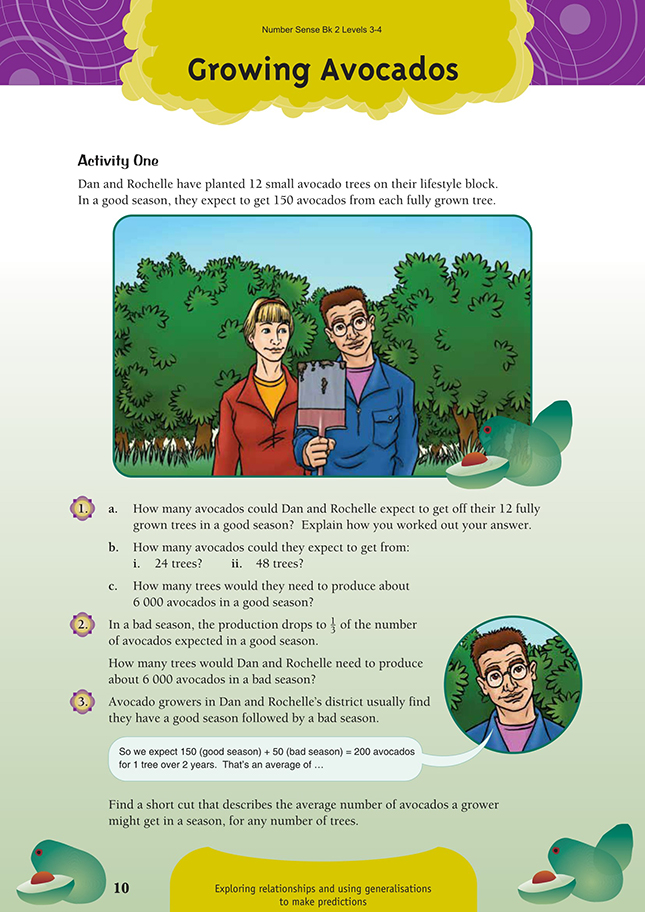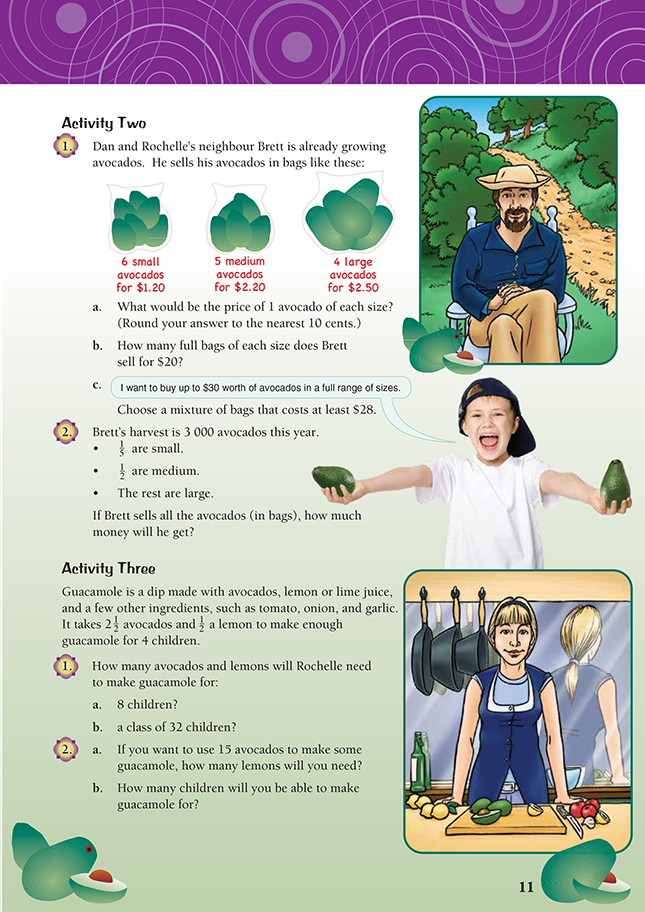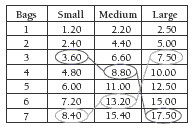This is a level 4 number activity from the Figure It Out series. It relates to Stage 7 of the Number Framework.
A PDF of the student activity is included.
Click on the image to enlarge it. Click again to close. Download PDF (808 KB)
use linear proportions to solve problems
Number Framework Links
These activities are suitable for students who use advanced multiplicative strategies (stage 7). They support the development of mental strategies to solve problems with fractions, decimals, and proportions, including the application of equivalent ratios and rates.
FIO, Levels 3-4, Number Sense and Algebraic Thinking, Book Two, Growing Avocados, pages 10-11
Activity One
While question 1 suggests a doubling strategy, there are a number of methods the students can use to obtain a solution. Get them to solve the problem independently and then share their strategies with a classmate. This will allow them to clarify and justify their methods and to see that other strategies are possible. You could then ask the students to solve a similar problem using the same strategies. For example, if the students solved question 1a by distributing the 12 as 10 + 2, ask them to use the same method to solve a problem involving 14 trees:
Avocados = 14 x 150
= (10 + 4) x 150
= (10 x 150) + (4 x 150)
= 1 500 + 600
= 2 100
In question 1b, the students could use doubling strategies to find out how many avocados Dan and Rochelle should expect from each tree: 12 x 150 = 1 800, so 24 x 150 = 1 800 + 1 800, which is 3 600, so 48 x 150 = 3 600 + 3 600, which is 7 200.
For question 1c, encourage the students to make and justify an estimate before they calculate the answer. From the previous questions, they will know that 24 trees are too few and 48 trees are too many. Ask them to explain the strategy they used as well as their answer. For example, working from results they already have:
12 x 150 = 1 800
8 x 150 = 1 200
20 x 150 = 3 000.
So 40 trees would produce about 6 000 avocados in a good season.
In question 2, the students need to understand that finding of the amount is the same as dividing by 3. If production per tree drops to , the number of trees must be trebled to obtain the same yield. This is an example of proportional adjustment:
40 trees x 150 avocados = 6 000 avocados in a good season
120 trees x 50 avocados = 6 000 avocados in a bad season.
In question 3, the students need to find the average yearly yield, given a good season and a bad season:
Therefore Dan and Rochelle’s average expected crop would be number of trees x 100.
Activity Two
In question 1a, the students need to calculate how much each size of avocado is worth, rounded to the nearest 5 cents. You may need to remind them how this is done. (See also the discussion on estimation and rounding at the start of these notes.) For this question, $1.20 ÷ 6 = 20 cents for a small avocado; $2.20 ÷ 5 = 44 cents for a medium avocado (rounded to 45 cents because we no longer have 1- or 2-cent coins); and $2.50 ÷ 4 = 62.5 cents for a large avocado (rounded to 65 cents).
Question 1b involves whole numbers only (as there is no indication that Brett will split the bags) and can be solved in a variety of ways, including counting on and doubling.
In question 1c, a customer wants to spend up to $30 on avocados in a mixture of sizes. The students are asked to spend at least $28 of the $30. Expect them to offer more than one solution, writing down both the total cost and the change from $30. Encourage them to use a table here. Then they can use a pencil to work out combinations that meet the criteria, for example:
In question 2, the students use their understanding of fractions to find out how much money Brett will get from his harvest. As part of the problem-solving process, they need to calculate (using a calculator if necessary):
• how many of each kind of avocado there are:
1/3 x 3 000 = 600 small avocados
1/2 x 3 000 = 1 500 medium avocados
3 000 – (1 500 + 600) = 900 large avocados
• how many bags there are:
600 ÷ 6 = 100 bags of small avocados
1 500 ÷ 5 = 300 bags of medium avocados
900 ÷ 4 = 225 bags of large avocados
• the total money Brett will get from the sale of each kind of bag: 100 x 1.20 = $120.00; 300 x 2.20 = $660.00; 225 x 2.50 = $562.50. 120 + 660 + 562.50 = $1,342.50
The students could set out this information more economically as a table:
Activity Three
In this activity, the students are finding proportional relationships between measures.
Encourage them to set out the information in a table and to discuss the links between the quantities.
Answers to Activities
Activity One
1. a. 1 800. Methods will vary. One method is:
(150 x 10) + (150 x 2) = 1 500 + 300 = 1 800
b. i. 3 600 from 24 trees
ii. 7 200 from 48 trees
c. 40. (6 000 ÷ 150. You might see this as 12 000 ÷ 300.)
2. 120 trees. (They need 3 times as many trees. 3 x 40 = 120)
3. Number of avocados
= (number of trees x 200) ÷ 2
or number of trees x 100
Activity Two
1. a. Small: 20c; medium: 45c (rounded); large: 65c (rounded)
b. 16 bags of small avocados; 9 bags of medium avocados; 8 bags of large avocados
c. Answers will vary. One possible answer is: 5 bags of large avocados ($12.50) + 5 bags of medium avocados ($11.00) + 5 bags of small avocados ($6.00) = $29.50
2. $1,342.50. That is, 600 small avocados in bags of 6 at $1.20 per bag = 1.20 x 100 = $120
1 500 medium avocados in bags of 5 at $2.20 per bag = 2.20 x 300 = $660
900 large avocados in bags of 4 at $2.50 per bag = 2.50 x 225 = $562.50
120 + 660 + 562.50 = $1,342.50
Activity Three
1. a. 5 avocados and 1 lemon
b. 20 avocados and 4 lemons
2. a. 3 lemons. (2 1/2 x 6 = 15. 6 x 1/2 = 3)
b. 24 people. (6 x 4)





